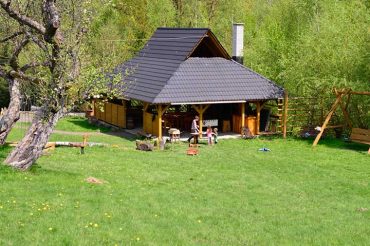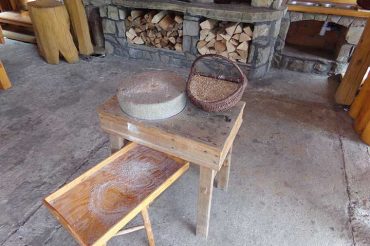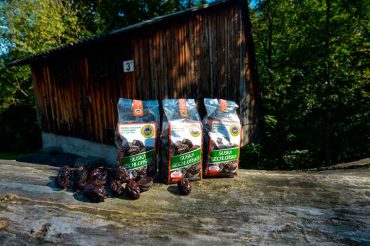INTRODUCTION
“Wiśniowy Gaj“ (“Cherry Orchard”) is a farm located in the Beskid Wyspowy Mountains area in Malopolska Province. It is surrounded by a traditional rural landscape, meadows, fields, forests, orchards, native species of trees, shrubs and flowers. The farm has a 200-year tradition and was inherited by women who gave it her whole heart. The farm runs agritourism and educational activities belonging to the Polish National Educational Farms Network.
But above all, it produces a regional plum “Suska Sechlońska” registered in the EU food quality system as a Protected Geographical Indication (PGI). Through its activities, the farm protects and brings closer the cultural heritage of the Polish countryside, its traditions, historical and landscape values and living in accordance with the rhythm of nature.

Multifunctional activities gives women great independence.
Life should be taken into your own hands.
It is worth departing from agricultural activity only and developing other activities.
Starting multifunctional activities is the only way for a decent life for woman in the countryside.
1. PERSONAL DATA
Name
Irena Szewczyk
Age Range
46 +
Education
Secondary ed.
Occupation
Farmer, rural entrepreneur, owner.
2. FARM PROFILE
Address/coordinates
Kobyłczyna 30, 34 – 603 Ujanowice.
Farm Area in ha
9 ha.
Date since when the female entrepreneur owns/rents the farm:
1993.
Nº of workers on the farms
| FULL TIME | |
|---|---|
| Family members | Other than family members |
| 4 | |
| PART-TME/SESONAL | |
|---|---|
| Family members | Other than family members |
| 3 | |
| WOMEN | |
|---|---|
| Family members | Other than family members |
| 2 | 3 |
Farm description
The farm is managed by a woman, who inherited the farm from her mother and together with family members, developed its activities towards the production of regional produce, tourist and didactic activities.
After taking over the farm, the owner began to limit crops and animal production, which had previously dominated the farm for the development of traditional orchard cultivation and other activities connected to rural heritage. Currently, almost the whole area of farmland is planted with fruit trees: plum, cherry, and apple and the main activity is focused on the production and sale of the regional plum “Suska sechlońska PGI” and other dried fruits. The farm belongs to the Fruit and Vegetable Producers Association and the Malopolska Fruit Trail. On the farm there is: a traditional wooden drying shed, a “cheerful barn” (gazebo) with grill and bar, which can seat up to eighty people, a playground, sports fields and animals: goats, rabbits, guinea pigs, chickens, ducks and ponies. Together these facilities provide multifunctional tourism and educational activities. Every source of income is associated with this place, and almost all family members are involved in running the farm. The owner cooperated with the country women associations (KGW) almost all her life. She plans to start one in her own village.
3. MULTIFUNCTIONALITY / RURAL CULTURAL HERITAGE
Multifunctional activities began in 2001. The decision to start other activities was directed by the desire to maintain and develop the farm as well as to obtain a higher income than was possible from agricultural production alone. The main activity of the farm, which is the production of regional plum, was possible thanks to the pre-war tradition of drying plums in this area. The whole process of plum drying and smoking is based on unique skills of local producers and must take place in a specific geographical area and in traditional drying sheds. Based on the traditions of the farm, its character and regional product, as well as the landscape heritage, the farm runs tourism and didactic activities. Belonging to the Whole Poland Educational Farms Network it offers didactic classes for groups of children and youth in the field of growing traditional orchards, traditional food production, ecology, nature and animals. A small open-air museum of old grain processing equipment was created on the farm to preserve historic methods. Using the potential of landscape heritage the farm has developed tourist and recreational activities, offering accommodation (agritourism) and additionally organising some activities such as mountains trips or camps for children. The owner is planning to expand the business to include formal tourist services. She also plans to breed deer.
4. CONSIDERATIONS, TRAINING / COMPETENCES INVOLVED
- General considerations
- Training/Competences (Knowledge, Skills, Attitudes) especially relevant for the process
Running current activity based on the potential of cultural heritage has enabled the farm to be maintained and it created the opportunity to continue its operation for future generations. As the main reason for success, the owner mentioned the life necessity and the desire to preserve the farm and her family. This convinced her to make a difficult decision limiting agricultural activity in favor of multifunctional activities generating more income. In the past a farm was a duty, today it gives a sense of financial security for the whole family. In the beginning, people did not believe that a woman, particularly in this area, could develop such a business. Currently, she is a model for young people - those coming to the farm can see that you can think differently about running a farm. The landlady regrets that she was not more determined in making decisions and did not implement many ideas that would have a chance to develop today. Access to loans and other sources of financing and knowledge is now much easier, which is a great support in starting and running multi-functional activities. It is worth cooperating with others; belonging to the Polish National Educational Farms Network gave her a big promotion. Greater profits from the sale of fruit were obtained after joining the producers group. The comprehensive and attractive tourist offer of the whole region based on heritage resources is important in this activity, because today’s client expects to know as much as possible about the region to which he goes, mainly through the prism of heritage. With the current situation, the owner sees further success in her business. In conclusion, she admitted that it is difficult to pave the way and startnew things, but it is worth doing. In the city, she would not have achieved such success.
In the owner’s opinion, the most important thing is to properly design multifunctional activities so that individual activities do not interfere with each other. Periods of work in agricultural activities, e.g. harvesting, may not coincide with the largest season of other activities, e.g. receiving guests, because then you have to give up something. It is important to have detailed knowledge related to the business and appropriate eligibility, if required. In problems related to the functioning of business, you can always use the knowledge and support of specialists (marketing specialist, lawyer, tourist guides). Important personality traits are courage and the ability to take a risk. In addition, creativity, communication and organisational skills. In this type of activity, personal competences related to the guests entertainment and, conducting educational classes, animations and tourist trips are important. Aesthetic approach and the ability to use the existing potential of cultural heritage are desirable. Training provided by agricultural advisory centers is a great substantive support.
Potential of cultural heritage, regional product;
Farm location – landscape heritage.
Young family members who will continue operating the farm.
Lack of comprehensive tourist offer promoting the nearby region based on heritage resources.
Increasing demand for discovering the world, spending time actively, exploring new places and local products.
Increasing interest in cultural heritage.
The need to adapt accommodation infrastructure to higher requirements of wealthier clients - the need for investment.













